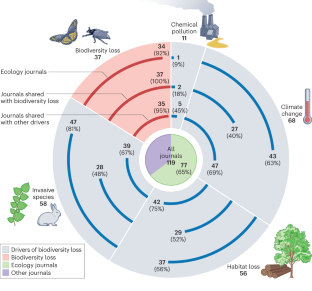Chemical pollution research should be better integrated with other drivers of biodiversity loss and the assessment of human impacts on ecosystems, to more effectively guide management strategies for biodiversity loss mitigation.
This is a preview of subscription content, access via your institution
Relevant articles
Open Access articles citing this article.
-
Glyphosate lessons: is biodegradation of pesticides a harmless process for biodiversity?
Environmental Sciences Europe Open Access 17 March 2024
Access options
Access Nature and 54 other Nature Portfolio journals
Get Nature+, our best-value online-access subscription
$29.99 / 30 days
cancel any time
Subscribe to this journal
Receive 12 digital issues and online access to articles
$119.00 per year
only $9.92 per issue
Buy this article
- Purchase on Springer Link
- Instant access to full article PDF
Prices may be subject to local taxes which are calculated during checkout

Data availability
All data are publicly available from the sources cited in the Supplementary Information. Source data are provided with this paper.
References
Tollefson, J. Nature 569, 171 (2019).
Johnson, C. N. et al. Science 356, 270–275 (2017).
Persson, L. et al. Environ. Sci. Technol. 56, 1510–1521 (2022).
IPBES. Global Assessment Report on Biodiversity and Ecosystem Services: Summary for Policymakers (IPBES secretariat, 2019).
Grier, J. W. Science 218, 1232–1235 (1982).
Oaks, J. L. et al. Nature 427, 630–633 (2004).
Bernhardt, E. S., Rosi, E. J. & Gessner, M. O. Front. Ecol. Environ. 15, 84–90 (2017).
Wang, Z., Walker, G. W., Muir, D. C. G. & Nagatani-Yoshida, K. Environ. Sci. Technol. 54, 2575–2584 (2020).
Carson, R. Silent Spring (Houghton Mifflin, 1962).
Köhler, H. R. & Triebskorn, R. Science 341, 759–765 (2013).
Sigmund, G. et al. Science 376, 1280 (2022).
Groh, K., Vom Berg, C., Schirmer, K. & Tlili, A. Environ. Sci. Technol. 56, 707–710 (2022).
Sigmund, G. et al. Glob. Change Biol. 29, 3240–3255 (2023).
Schuijt, L. M., Peng, F. J., van den Berg, S. J. P., Dingemans, M. M. L. & Van den Brink, P. J. Sci. Total Environ. 795, 148776 (2021).
Brack, W. et al. Environ. Sci. Eur. 31, 62 (2019).
Brack, W. et al. Environ. Sci. Eur. 31, 10 (2019).
Medina, M. H., Correa, J. A. & Barata, C. Chemosphere 67, 2105–2114 (2007).
Blowes, S. A. et al. Science 366, 339–345 (2019).
van den Brink, P. J., Roelsma, J., Van Nes, E. H., Scheffer, M. & Brock, T. C. M. Environ. Toxicol. Chem. 21, 2500–2506 (2002).
Senf, C. Ecosystems 25, 1719–1737 (2022).
Carraro, L., Mächler, E., Wüthrich, R. & Altermatt, F. Nat. Commun. 11, 3585 (2020).
Ågerstrand, M. et al. Environ. Sci. Technol. 57, 2205–2208 (2023).
UNEP CBD (Convention on Biological Diversity). COP15: final text of Kunming-Montreal Global Biodiversity Framework. cbd.int, https://www.cbd.int/article/cop15-final-text-kunming-montreal-gbf-221222 (22 December 2022).
Acknowledgements
The authors have been supported by the RobustNature Excellence Initiative (internal prefunding of the Goethe University Frankfurt).
Author information
Authors and Affiliations
Contributions
F. Sylvester, F.G.W. and H.H. conceived this work. F. Sylvester, V.L.L. and F.G.W. conducted the literature searches and data analyses with the help of S.F., K.J.G., J.J., S.J., F.L., R.O., J.P., M.P., S.S., M.S.-S. and F. Strobl. Writing was led by F. Sylvester with extensive input from H.H. Substantial contributions to writing and the direction of the manuscript were made by K.J.G., K.T., M.S., W.B. and J.J. Figures had substantial input from L.M.S., F.G.W, V.L.L., M.S.-S. and F. Sylvester. All other authors (M.B., L.B., C.B., B.B., J.C., P. Dierkes, P. Döll, I.E., E.J.N.H., T.H., S.K., H.K., D.M., T.M., J.O., S.U.P., G.J.S., J.F.S., A. Schlottmann, F. Schneider., E.S., F. Strobl, A. Sundermann, T.T., A.V., C.V. and R.W.) contributed to specific aspects and to further elaborate the manuscript. All authors read and approved the final manuscript.
Corresponding author
Ethics declarations
Competing interests
The authors declare no competing interests.
Supplementary information
Supplementary Information
Supplementary Methods.
Supplementary Data 1
Random papers reviewed to assess to what extent the Scopus searches conducted yielded papers on the topics targeted by the present study. We examined 100 papers for each of the five topics assessed (500 papers examined in total): chem, chemical pollution; cc, climate change; land, habitat degradation and loss caused by changes in land and water use; nis, invasion by non-native species; and bio, biodiversity loss.
Supplementary Data 2
Number of published papers per year retrieved by Scopus searches (1990-2021) on five assessed topics: chemical pollution (chem), climate change (cc), habitat degradation and loss caused by changes in land and water use (land), invasion by non-native species (nis), and biodiversity loss (bio).
Supplementary Data 3
Number of published papers per journal retrieved by Scopus searches (1990-2021) on five assessed topics: chemical pollution (chem), climate change (cc), habitat degradation and loss caused by changes in land and water use (land), invasion by non-native species (nis), and biodiversity loss (bio). The journals are ranked in decreasing order of paper contribution, and the tables show the first 158 journals with the largest contribution in each topic.
Source data
Source Data Fig. 1
The most productive journals, accounting for 50% of the papers published on five topics: chemical pollution (chem), climate change (cc), habitat degradation and loss caused by changes in land and water use (land), invasion by non-native species (nis), and biodiversity loss (bio) searched in Scopus between 1990 and 2021. These journals are a subset of 119 journals out of a total of 367 identified journals. The Scopus sub-subject area information is provided for each of the 119 journals.
Rights and permissions
About this article
Cite this article
Sylvester, F., Weichert, F.G., Lozano, V.L. et al. Better integration of chemical pollution research will further our understanding of biodiversity loss. Nat Ecol Evol 7, 1552–1555 (2023). https://doi.org/10.1038/s41559-023-02117-6
Published:
Issue Date:
DOI: https://doi.org/10.1038/s41559-023-02117-6
This article is cited by
-
Glyphosate lessons: is biodegradation of pesticides a harmless process for biodiversity?
Environmental Sciences Europe (2024)
-
Validation of qPCR reference genes in the endangered annual killifish Austrolebias charrua considering different tissues, gender and environmental conditions
Ecotoxicology (2024)
